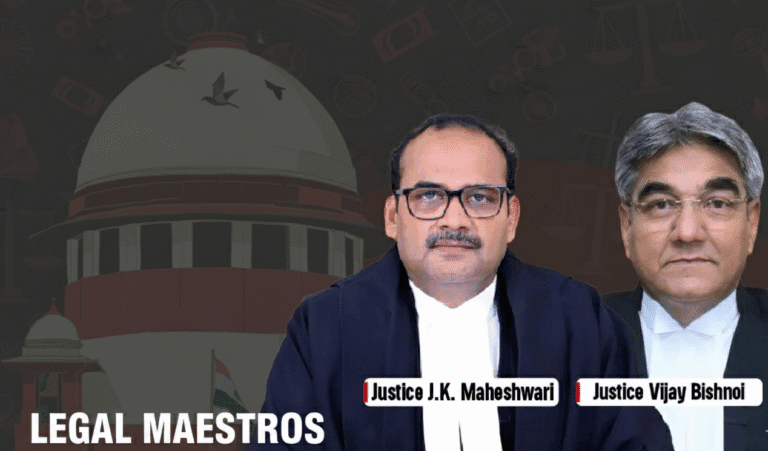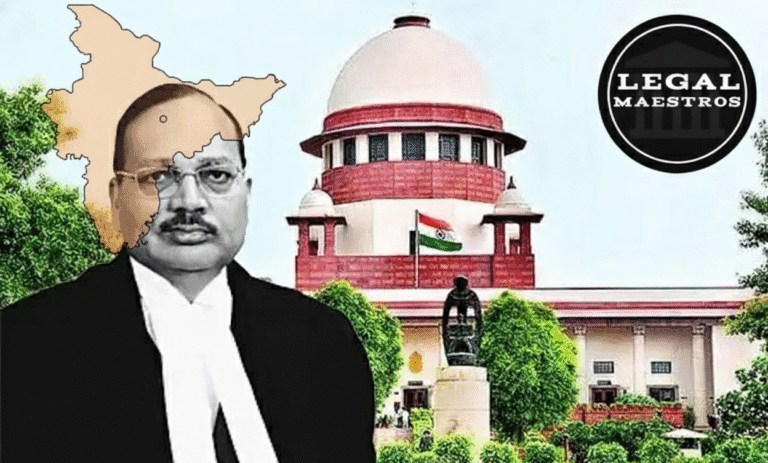
The case was observed by the Supreme Court of India in the Criminal Appeal Nos. 331-332 of 2022, which concerned one of the most heinous crimes involving a 10-year old female child, known by the initials of ‘X’ as the name itself was supposed to be kept confidential. On July 28, 2018, X disappeared in the course of playing around her house. Her father Sant Pratap (PW1) started a hysterical search. When he interrogated other kids, they informed him that the appellant came and took them to his hut, and provided them with money so that they could go shopping in a shop, but, the rest of the kids went home but X did not yet come back. At last, a dead body of X was discovered in the vehicle of the appellant, which was locked inside an empty cement bag. An FIR was filed and appellant was arrested and investigation was made.
As it was found based on the results of the post-mortem done by Dr. Chirag Bahugana (PW4) to whom it was disclosed that a lady with identity as X was raped and cause of her death was due to the aspect of manual strangulation that caused asphyxia. Following the investigation, the case was booked against the appellant under Section 302 (murder), 201 (causing the disappearance of the evidence of offence),376 (rape) and 377 (unnatural offences) of the Indian Penal Code, 1860 and Section 6 of Protection of Children against Sexual Offences Act, 2012.
The High Court Trials and the Proceeding with the Death Sentence and the Conviction
In the judgment of August 26/28, 2019, the Trial Court most diligently examined the evidence and, after convicting the appellant of the offenses U/S 376 (AB), 377, 302 I.P.C. and 5 / 6 of the POCSO act. Notable evidences were that the deceased was last seen in the company of the appellant, her body was retrieved in his hut and the vital DNA was found matching those of the appellant. In particular, the DNA that was retrieved in the hair on the body of the child which is called herein as X and her underwear matched the DNA of the appellant. The Trial Court declared it a crime of the rarest of rare cases; it was cruel in nature, that is, strangulation of a defenceless child, and so, the appellant received the death penalty. It indicated that even the creation of the appellant who is in his 30s, and a father by himself was old enough to be able to know the implications of the actions that he was undertaking.
For any queries or to publish an article or post or advertisement on our platform, do call at +91 6377460764 or email us at contact@legalmaestros.com.
After that, the appellant challenged the order of the trial before the High Court of Uttarakhand at Nainital. A report confirming the death sentence was provided at the High Court as well according to S. 366 of the Code of Criminal Procedure, 1973. In its verdict dated January 7 2020, the High Court affirmed the decision besides upholding the death sentence. It has pointed out the fact that the appellant has admitted himself being in his room on the day of the crime, discovery of the body of x in his room and the coincidence of DNA as some of the direct measures in which the appellant is guilty. The High Court has also dismissed the theory that the child witnesses (PW11 and PW12) had been tutored basing on the supporting evidence.
Evidence that was considered by the Supreme Court to uphold conviction: Upholding Conviction
The Supreme Court carefully examined the case concentrating on three major events which included the discovery of the body of X in the hut belonging to the appellant, the last seen theory and DNA. In regard to conviction the Court did not find the findings of the lower courts to be infirm.
In response to the body recovery, Mohd. Naiyar (PW3) gave evidence to the effect that he discovered the dead body of X under cement bags in the hut of the appellant and this has been supported by PW1 and PW2. The Court added that the statement given by PW3 was not subjected to any cross-examination and even in this regard PW10 (SI Raj Vikram Singh) on the basis of which the presence of dead body in the hut of the appellant was established was examined. It is this fact that should have been used against the appellant.
For any queries or to publish an article or post or advertisement on our platform, do call at +91 6377460764 or email us at contact@legalmaestros.com.
A theory of last seen was also quite implemented. Somwati (PW13), aunt to X testified that she witnessed the appellant taking away with X and other children yet only children made their way back. This was further supported by other child witnesses, Master Rakesh (PW11) and Rani (PW12) who are cousins of the accused and have been interrogated as child witnesses and they confirm the case that the accused gave them 10 rupees each but did not release the accused despite their repeated requests that they only wanted to see their cousin. The testimonies of these child witnesses were held as credible and inspiring confidence by the Court and its conclusion was that the appellant was actually last seen with X inside his hut just before the incident and nobody was with them.
To be most important, the DNA evidence which appeared in the case of Dr. Manoj Kumar Aggarwal (PW17) stood unopposed. The DNA derived out of hair on the body of the appellant (Ext.4) and under garments underwent testing and tallied with the DNA of the appellant. What is more, DNA of the underwear belonging to X (Ext.9) was matched with samples of both the appellant and X. A chain of seizure and examination of these articles did not make any infirmity to the Court and they held that the prosecution had made out its case beyond a reasonable doubt in the view of all the circumstances cumulatively. The Supreme Court thus upheld the parallel findings of guilt on the appellant.
Reconsidering the Statement: Barbaraity Vs. the Test of the Rarest of the Rare
In maintaining the conviction, the Supreme Court took a long time discussing the death sentence given by the lower courts. The fact that the crime was of extreme inhuman nature involving a poor child being lured, raped and then being strangled, so as to conceal evidence, was recognised by the Court. Having said that, it clarified that the heinous nature of a crime should not be the only guideline that should be used to qualify a case under the category of the rarest of rare in order to attract the death sentence.
For any queries or to publish an article or post or advertisement on our platform, do call at +91 6377460764 or email us at contact@legalmaestros.com.
In the case, the Court cited earlier rulings, especially Mohd. Farooq Abdul Gafur against. State of Maharashtra, in which the heavy load on the court in capital sentencing was pointed and it also implied a focus on life imprisonment in cases that were founded on the basis of simply circumstantial evidence. It has also referred to Gudda v. State of M.P., holding that brutality alone can not be determinant of the rarest of rare. The lower courts were criticized by the Supreme Court since they only spoke in terms of the heinous nature of the crime and did not speak in terms of aggravating and mitigating circumstances.
The Manoj V decision. Case of State of M.P. was cited which further stressed a two-step process to come up with the rarest of rare category, namely, arriving at the aggravating and mitigating circumstances and equally weighing the two, and second, being able to declare that life imprisonment is an absolute nonstarter, which means that reformation cannot take place. Failure to determine mitigating circumstances and the opportunity of reformation and rehabilitation of the appellant in detail is the error committed by the lower courts in consideration of the case in point.
The Closing Verdict and Mitigating Circumstances
The Supreme Court followed the mitigating circumstances such as the reports offered by the probation officer and the psychological test done on the appellant. The report created by the District Probation Officer, Ayodhya dated April 12, 2022, indicated the socio economic status of the family the appellant belonged to being very pathetic and used to work as laborers. As it was stated in the psychological report of April 19, 2022, the appellant was not able to go to school because of the situation at home and began to work when he was twelve years old. Notably, it also added that he was good in getting along other prisoners and did not experience any psychiatric disturbance.
For any queries or to publish an article or post or advertisement on our platform, do call at +91 6377460764 or email us at contact@legalmaestros.com.
In view of these mitigating factors, and the narrow standard of the category which constitutes the rarest of the rare cases, the Supreme Court had deemed it fit to reduce the death penalty. Accordingly the Court amended the impugned High Court order and replaced the capital punishment with the life imprisonment without remission extending to natural life (of the appellant). This ruling highlights the reason that the Supreme court remained committed to a middle ground approach where a truly heinous crime is not subjected to mere punishment but that at the same time the principles of justice, proportionality, and reformation are kept in mind even when dealing with truly ferocious crimes.




![Research Assistantship @ Sahibnoor Singh Sindhu, [Remote; Stipend of Rs. 7.5k; Dec 2025 & Jan 2026]: Apply by Nov 14, 2025!](https://legalmaestros.com/wp-content/uploads/2025/11/Gemini_Generated_Image_s0k4u6s0k4u6s0k4-768x707.png)
![Karanjawala & Co Hiring Freshers for Legal Counsel [Immediate Joining; Full Time Position in Delhi]: Apply Now!](https://legalmaestros.com/wp-content/uploads/2025/11/Gemini_Generated_Image_52f8mg52f8mg52f8-768x711.png)
![Part-Time Legal Associate / Legal Intern @ Juris at Work [Remote]: Apply Now!](https://legalmaestros.com/wp-content/uploads/2025/11/ChatGPT-Image-Nov-12-2025-08_08_41-PM-768x768.png)
![JOB POST: Legal Content Manager at Lawctopus [3-7 Years PQE; Salary Upto Rs. 70k; Remote]: Rolling Applications!](https://legalmaestros.com/wp-content/uploads/2025/11/ChatGPT-Image-Nov-12-2025-08_01_56-PM-768x768.png)
1 thought on “Justices V.Nath and S. Karol and S. Mehta Rule Death Not Justified: Supreme Court Says Life Imprisonment Till Natural Death Is Enough in Case of 10-Year-Old Girl’s Killing”